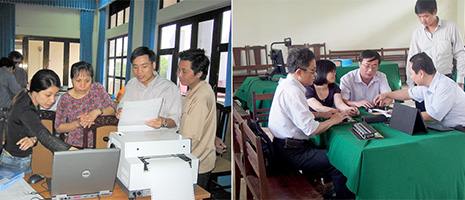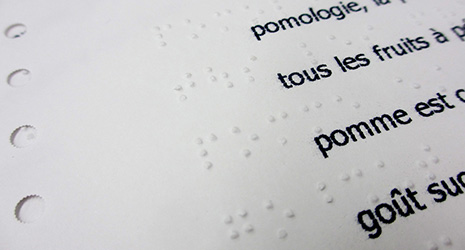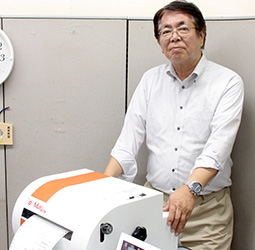Home > Highlighting JAPAN > Highlighting Japan August 2017 > SMEs Overseas
Highlighting JAPAN


Braille for All
A Japanese software developer has developed a range of braille printers that is benefiting both visually impaired and sighted users around the world.
Of the Japanese IT companies, Nippon Telesoft Co. stands out as unique. While developing software for power plant control and traffic control systems, it also produces ICT peripheral devices for visually challenged people. Nippon Telesoft started this line of business when a person involved in government administration once shared his concerns with them: “We ask a braille transcriber to create handouts for visually challenged people, but we can neither detect errors nor make detailed orders since we cannot read braille.” Under the company’s corporate philosophy, “Use technology to overcome technological challenges,” Nippon Telesoft developed braille translation software that allows even those not familiar with braille to easily create a document in braille. Since then, it has developed products such as refreshable braille displays and a Braille KARAOKE System that synchronizes song lyrics on a monitor with a user’s braille display. Meanwhile the company’s braille printers, which have the largest domestic share, are the only Japan-made braille printers to have advanced overseas.
“Twelve employees do everything from development, through designing and manufacturing, to sales. We have improved our braille printers by gradually adding functions for more than ten years. While manufacturers from northern European countries, which work to improve welfare as a national commitment, have 70% of the world share, we have managed to gain a share of a little less than 10%. I believe that this is due to our products’ additional values generated by our capabilities to develop both software and hardware,” says Hideaki Kaneko, president (CEO) of Nippon Telesoft.
The braille printers developed by Nippon Telesoft are equipped with an innovative function for the simultaneous printing of braille and non-braille ink characters. The printers, which can handle 100 different languages, received the Special Prize from the Tokyo Venture Technology Award 2003. While conventional braille printers punch the braille dots into paper, Nippon Telesoft’s printer features a delicate mechanism that presses paper against pins to minimize the operational noise and vibrations, making it barrier-free.
“Generally a braille printer makes a loud noise when it prints. We were aware that braille printers installed at schools could only be used early in the morning before the students arrive. If we focus on the development of specialized technology for visually challenged people only, we limit the utility of that product to those who are challenged. We develop our products to be accessible by those who support visually challenged people as well,” says Kaneko.
The braille printers of Nippon Telesoft have further broadened the possibilities for the already mature welfare services in developed countries. For example, they have revolutionized over-the-counter services in hospitals and banks. Staff who are unfamiliar with braille can create braille documents that contain important information, such as the type of medicine and its dose or a bank account status, by checking the information written in non-braille characters.
For the devices aimed at developing countries, the company provides user support in addition to product delivery.
Since 2016, Nippon Telesoft has been working on a project in Vietnam for the empowerment of persons with disabilities that was adopted by the Japan International Cooperation Agency (JICA) under its Support for Japanese Small and Medium Enterprises Overseas Business Development program (“Verification Survey with the Private Sector for Disseminating Japanese Technologies for an ICT Education Center Aiming to Improve Empowerment for Persons with Disabilities”). In Vietnam, out of the total population of about 100 million, 1 million people suffer from visual disability, and when weak eyesight is included, the number rises to 3 million. Although the Vietnam Blind Association (VBA) has started establishing centers to support visually challenged people in urban locations and other areas, the situation remains harsh and many handicapped people are cared for by their families and remain indoors.
In cooperation with the VBA, Nippon Telesoft has established ICT courses in Hanoi and Hue, and plans to provide learning support and classes on personal computers and administrative software to give visually challenged people educational and employment opportunities.
“Although personal computers and smartphones are very comfortable to use for able-bodied people, they are indeed very difficult to use for visually challenged people. We are striving to remove this handicap by providing auxiliary components and software that overcome handicaps with the functions of voice and braille,” explains Kaneko.
Making use of the company’s experience of exporting its products to ASEAN countries, Nippon Telesoft has already delivered ten braille printers that have been specially adapted for humid climates. The VBA has great expectations for the courses.
© 2009 Cabinet Office, Government of Japan







